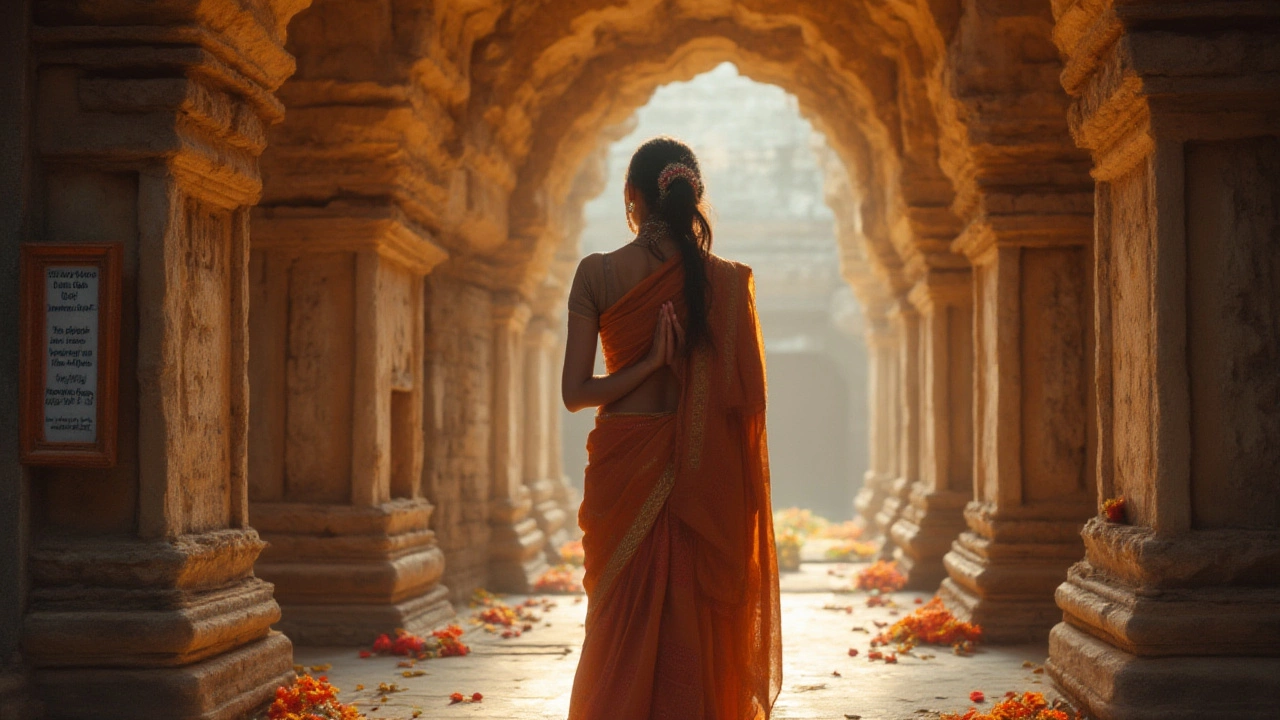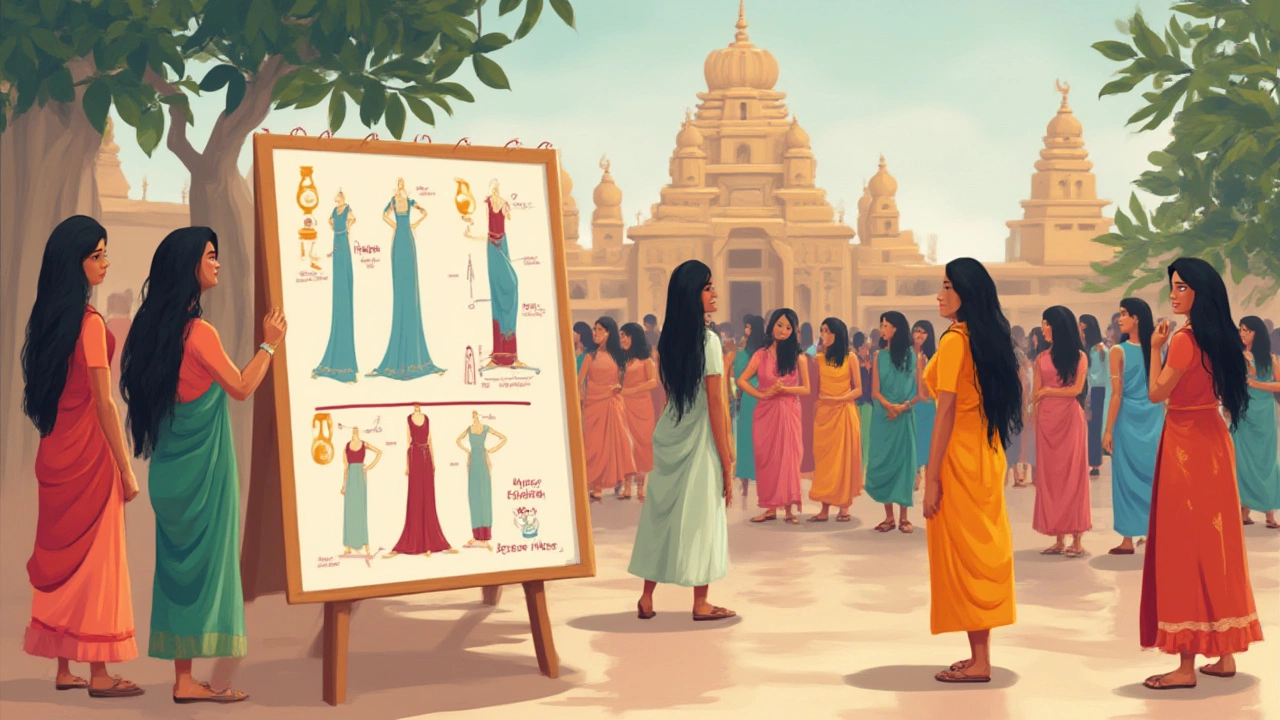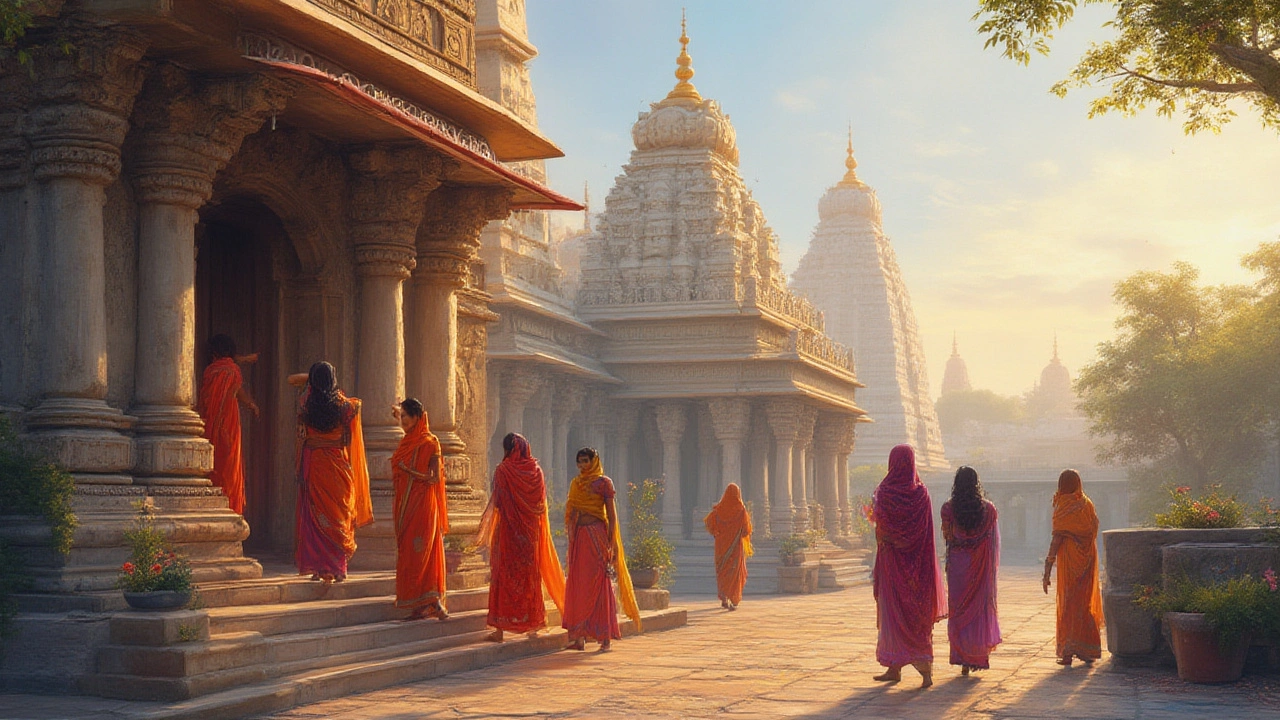Walk up to any grand temple in India and you’ll see more colors than an artist’s palette, but there’s one thing you won’t find: people ignoring tradition when it comes to dress. Temples aren’t museums or public parks—they’re living, breathing places of worship, and folks hold their dress codes seriously. Stories are everywhere. My son Linus once innocently asked why a lady was given a shawl before entering a temple in Rameswaram. The answer’s simple and old-school. Respect. You might hear about people being turned away, or gently offered a scarf, sometimes even in the hottest part of summer. The rules aren’t there to embarrass anyone—they’re rooted in generations of customs. Yet, the specifics can trip up travelers, especially if you’re coming from outside India or just haven’t been before. If all this sounds confusing, don’t worry. I’ve been down this road with my own family.
Why Temples Have Dress Codes
Indian temples don’t just look old—they carry thousands of years of rituals on their shoulders. There’s a rhythm behind the rules, most set down to show humility and maintain the sacred vibe. Across India’s north and south, east and west, temple-goers are expected to cover up decently: skip the shorts, leave the tank tops, and grab something that sweeps below the knees. Conservative? Sure. But for many, temple visits aren’t about making a fashion statement—they’re about connection and respect. In some temples, you’ll notice locals wearing only traditional outfits like the saree or salwar kameez, and nobody bats an eyelid if you show up in a well-fitted kurta with leggings. The stress is always on modesty—avoid clothing that clings or is see-through, and better to keep those shoulders covered.
What about children or teens? Most places are flexible. Still, bright spaghetti straps or miniskirts for girls will raise some eyebrows, so err on the side of caution. Cleaning up before entering matters a lot too. Wash your hands and feet. Even today, many temples keep water bowls or foot-washing taps near the entrance.
There’s an interesting divide: South Indian temples, especially famous ones like the Meenakshi Temple or Guruvayur, can be far stricter than those in North India. In Kerala, some temples even restrict entry to women during certain times—from local traditions, not official policy. At Guruvayur, the sign just says “no western wear.” But plenty of temples make do with a polite request: cover your head, shoulders, knees. If you forget, don’t sweat it. Outside, you’ll find shawls or wraps being offered for a few rupees—or even for free.
Let’s not sidestep shoes and accessories. No one walks inside with shoes on. Some temples have lockers, others leave shoes stacked in neat chaos at the entrance. Fancy jewelry is fine but keep noisy bangles and chunky bracelets to a minimum—most worshippers prefer a look that doesn’t ring and jingle during prayers. Phones and cameras? Loads of temples don’t allow photos inside sanctums; some won’t let you take electronics in at all. So, travel light.

What to Wear: Practical Outfits and Tips for Girls
The “right” outfit changes depending on which temple you’re visiting, but the basics rarely shift: cover the shoulders and legs, and avoid revealing, tight, or flashy outfits. So what actually works best? Here’s the no-nonsense checklist for girls, from toddlers to teens:
- Long skirts or maxi dresses: Skip anything short. A loose skirt paired with a simple tee always fits the bill.
- Salwar kameez or churidar: Classic, practical, and easy to buy anywhere in India. Don’t forget the dupatta scarf—it’s handy for covering the head or shoulders.
- Kurtas and leggings: Another simple combo. Make sure the kurta covers your backside and isn’t see-through. Cotton is your best friend, especially during summer.
- Saree: For those who can manage it, sarees are the gold standard in some temples. If not, don’t worry—locals appreciate any sincere effort to blend in.
- T-shirts and palazzos: If you can’t find traditional wear, at least pair a simple, loose-fitting tee with full-length bottoms. No workout gear, yoga pants, tights, or shorts.
- No hats or caps, but many temples expect girls and women to cover their heads with a scarf or dupatta—especially Sikhs and Muslims, but also in some Hindu shrines.
- Keep prints simple—avoid wild or loud slogans, especially anything religious or political.
Most Indian families plan ahead by packing an extra scarf in their bag. If you’re a traveler, ask your hotel—staff have seen these questions a thousand times and usually point you in the right direction. Street vendors outside temples often sell cheap dupattas or shawls if you forget yours. Wash them at the hotel and save them for next time.
Now, a quick story: Temple dress codes aren’t just for “outsiders.” Local girls, too, get gently reminded if their outfit crosses a boundary. When Linus’ friend Mita visited the Somnath temple in shorts, the volunteer at the door handed her a wrap skirt with a sheepish smile and a “welcome back” once she changed. No lecture, just a nudge to follow the rules. Nobody’s out to embarrass anyone.
If you want numbers, here you go. According to a 2024 survey by the Indian Ministry of Culture, 88% of temples in South India have a prescribed dress code, while 65% in the North do. But the unspoken rule everywhere? “Dress to blend, not to stand out.” Even international tourists—almost 62%—say they prefer traditional clothing for temple visits to avoid any trouble.
Some families make this a teaching moment for kids. Getting a child into a churidar can feel like herding cats, but it’s a chance to talk about respect that goes beyond just clothing. That lesson sticks, trust me. Linus still talks about why temples care about “outside dirt” and why everyone, even the smallest toddler, takes off shoes before stepping in.
| Temple Region | Dress Code Strictness | Common Attire Recommended |
|---|---|---|
| South India | Strict | Saree, salwar kameez, long skirts, covered shoulders |
| North India | Moderate | Kurta with leggings, salwar kameez, dupatta |
| Western India | Variable | Long dress, saree, skirt, modest western wear with scarf |
| Eastern India | Relatively Flexible | Long skirt, saree, basic modesty applies |

Tips for a Smooth Temple Visit with Kids and Teens
Taking kids or teens to temples in India sounds simple, but let’s be real—it’s rarely a calm, breezy affair. Girls especially get tangled up in “what can I wear,” parents forget a spare scarf, or someone insists on photos only to hear “NO PHOTOS” from the priest. Here’s what I tell everyone headed out with their family (and what I made sure Linus memorized):
- Plan clothing the night before. Picking out temple-friendly outfits in the morning rush often leads to mistakes. Lay out long pants, shirts, and dupattas ahead of time.
- Double-check the temple’s dress code online. Many famous temples have their own websites with clear instructions or printable guides. If not, travel blogs or TripAdvisor usually carry up-to-date advice, especially after 2024 policies tightened at major South Indian shrines.
- Pack a lightweight scarf or dupatta in your bag, even if you aren’t expecting to need it. That goes double for girls and women.
- Explain the “why” behind the rules to kids, even stubborn teenagers—they’re often more receptive if they know it’s about respect, not just about “fitting in.”
- If anyone in the family is wearing shorts or sleeveless tops, keep a backup wrap skirt or t-shirt handy—most security guards at temple gates are friendly but firm about halting folks until they cover up.
- Arrive early if you want to beat crowds—and the glare of the midday sun, which makes heavier outfits tough for children to handle.
- Encourage comfy shoes that are easy to slip on and off. Sandals or flip-flops work but always mind the shoe racks—temple grounds aren’t the place to break out your fanciest sneakers, unless you don’t mind them getting lost.
- Stay hydrated and keep a packet of tissues or hand sanitizer. Washing before you enter the temple is key, and sometimes lines can be long at popular shrines.
- Ask before taking photos or videos, especially inside the sanctum. Most temples post signs in English and local languages. Breaking the rule means the nearest priest, or worse, another devotee, may scold you (in full view of everyone… not fun).
People sometimes worry girls will be judged or stared at. From my experience, as long as they’re respectful, nobody cares much about looks. During festivals, when the temple is packed, everyone’s outfit is a riot of color and style, but dignity and modesty always stand out more than anyone’s clothes. A quick head count from the 2024 Maha Shivratri at Kashi Vishwanath put over 5,00,000 visitors through the gates—yet the scene was orderly because everyone stuck to the code, foreign tourists included. Not bad for a dress code that’s mostly unwritten and community-enforced.
If you’re thinking, “What if I make a mistake?”—relax. Temples aren’t trying to gatekeep; their role is to make every visitor feel the spirituality, not the shame of a wardrobe malfunction. Each time you follow the dress code, you aren’t just following the rules—you’re joining in with the centuries-old rhythm of millions who’ve stood barefoot on those cold stones before you, wrapped in humility and belonging. Pretty cool way to connect with India, if you ask me.
